
Issue #: 140
Published: March / April 2015
- Price per issue - digital : 5.40€Digital magazine
- Access to Multihulls World digital archives Digital archives
The crew of Jangada find a little blue paradise on the tiny island of Maupiti, located a little less than 30 miles west of Bora Bora…
Maupiti is the last of French Polynesia’s Leeward Islands to be served by sea and air transport links from its neighbors to the east, Bora Bora and Raiatea. Oh, there isn’t a flight every day, only 2 or 3 a week. And the Maupiti Express, the little passenger ferry which runs to Bora Bora and Raiatea, only makes the trip every 2 or 3 days. When the pass can be entered, of course! If not, she remains tied to the dock. Further west, you find the final reaches of French Polynesia, with Mopelia, and then the tiny little lost atolls of Bellinghausen and Scilly, which are uninhabited. Maupiti really is a jewel - a high island (380 meters) dropped in the middle of a lagoon of enchanting colors. A lagoon of sparkling beauty. Maupiti, a miniature jewel, lives to the rhythm of pushbikes and scooters which ride peacefully round the one road which circles the island, in the middle of the lagoon. On the surrounding motus, the Polynesians grow watermelons, and have recently started a few family-run guesthouses for the savvy tourists (I would recommend, once in your life, to spend a week at the Rose des Iles guesthouse, or at the Maupiti Village guesthouse on the Tiapaa motu, close to the pass…).
There are no hotels here, the locals don’t want them. In spite of having a little airport, one of the most picturesque in the world. The little village, with its beautiful flowers, is spread out along the foot of an imposing cliff of volcanic rock some 230 meters high, a reminder of the island’s geological origins. Gone are the bungalows on stilts of Bora Bora! Gone are the jetskis! Never mind about the shopping! No pearl stores here… nor pirogue canoes overflowing with tourists. But of course the manta rays have remained here in Maupiti’s lagoon. So we watched them, and swam with them… The inhabitants of Maupiti have been very wise, and have managed to preserve their charmed way of life and let time take care of itself, peacefully. By refusing the money, they have said no to stress, to consumerism and to the degradation of their environment. And they have retained the joy of simple living. They make a living from growing a few vegetables on the motus around the lagoon’s rim, harvesting fruit, fishing for mahi-mahi (dorade coryphene) from their traditional potimarara fishing boats, or more simply catching fish from the lagoon such as snapper, parrotfish or jacks. There’s no ciguatera in Maupiti: this little corner of paradise has not been polluted by toxins! We’re glad we ignored everyone who said, “Maupiti? Forget it - the pass is too dangerous!” But… you do still need to be careful! The pass at Maupiti really can be dangerous. It has a bad reputation, which is justified. But too dangerous? That depends on the conditions, and also the experience of the crew who attempt it. There’s only one solution: the problem must be properly investigated before taking responsibility. Everyone knows that in order to get to Heaven, you have to pass through purgatory first. Maupiti has its purgatory (the pass), and this is the only means of reaching its heaven (the lagoon). In recent decades, the pass has claimed several souls, taken by the surf and by the reef on Heaven’s behalf. There was no manuia (luck, in Polynesian) for the Manuia, in 1963: 15 people lost. There was better luck more recently for the Aremiti ferry, when she was carrying almost 300 passengers. The big powerful aluminum trimaran went off course in the pass, and was lifted by the surf and ended up high and dry on the reef. Fortunately everyone on board was able to disembark on foot onto the motu…
Nearly there…
Aboard Jangada I sure love adventure, but also, in the spirit of adventure, need to remember how to keep the brain firing on all cylinders. To be able to work it out for myself, using my own judgment and my own experience. And finally to have enough knowledge of the causes and effects. Being able to make the right decision means collecting information from the right sources, then analyzing the risk and the conditions required to bring that risk to an acceptable level, that is to say to a minimum. Developing an approach strategy and the relevant technical configuration, then… decision. A recipe which helps overcome many obstacles, whether on a motorbike in the Sahara or sailing among icebergs in Antarctica. Or even approaching the pass at Maupiti…
A pass which worries most cruising sailors, who we later saw from the anchorage inside, giving the island a wide berth, en route to Palmerston or Rarotonga in the Cook Islands. I began a few days ago with a little trip in the dinghy when we were at Uturoa (Raiatea) and then at Tahaa, and had a chat with the skipper of the Maupiti Express, the expert on the pass. Being both professional merchant navy seafarers, we immediately clicked, and with paper and pen in hand, Théodore explained all the confusion. On leaving the bridge fifteen minutes later, I knew more about the pass at Maupiti than from reading all the English language Pacific pilot guides, which I still don’t have on board!
15 dreamy days in paradise!
Maupiti’s only pass is located at the south of the island, and it is just the right shape to be frequently menacing. First of all, it is the only pass. That is to say that all the water coming in or out of the lagoon has to pass through it. Next, it is narrow, barely more than 50 meters wide. And then, for several millennia, it finds itself with a motu either side. The motus of Tiapaa to starboard when entering, and Pitihahei to port, which between them form a splendid funnel! But then again, the pass is well-marked. However, almost certainly due to ease of installation or need for its concrete base to be protected from the constant waves, the green starboard mark is curiously set too far to the right, tucked in a recess in the reef. So, the sailor who is not paying quite enough attention, who strays even just a little from lining up the entrance, simply concentrating on staying in the middle of the theoretical channel, halfway between the red and green buoys, stands every chance of ending up on the reef to starboard of the channel, as this is several meters closer toward the middle than indicated, well inside the green buoy. And significantly ahead of it… Let’s just say it wasn’t such a bright idea on the part of the Coastguard buoyage department. This little opening in the coral is naturally exposed to the full force of the swell emanating from the Southern Pacific and the region of the Austral Islands, when depressions make their way up from the confines of the roaring forties… And when this southerly swell meets the pass at Maupiti, the conditions are not pretty… Better, then, to carry on your way if you’re on the outside, unless you have made your peace with the Good Lord and decide to give the entrance a try, which I have to say would constitute a huge mistake. And if you’re inside the lagoon, stay awhile and enjoy yourself, and wisely wait for it to be completely calm, for the swell to have disappeared and the wind to have shifted. Ahead of prudently making an attempt on the pass, but first having made a recce on foot from the motus.
When the swell is running anywhere from southeast to southwest, the pass at Maupiti is a dantean maelstrom: the current pours out, at rates which can exceed ten knots, and in the bottleneck that meets a swell of 3 to 4 meters, provoking a staggeringly confused sea, which nothing can fight against. We were able to go and observe just such a phenomenon during our almost two week stay in Maupiti, and truly, I wouldn’t wish that on anyone! But the main reason for the bad reputation of the pass at Maupiti lies elsewhere. It is of a hydrological nature.
When a depression whips up westerly winds from far in the southern Pacific, the swell comes up towards the tropics, at a speed in the order of thirty or so knots. When this swell reaches the little coral ring at Maupiti, it transforms into waves which incessantly pound on the very low-lying coral flats at the south west corner of the atoll. This is why none of the motus in this part of the atoll are able to hold back the assault from the sea. A self-perpetuating natural phenomenon. As a result, each swell coming out of the south to southwest dumps a huge volume of water into the lagoon, via the coral flats and the large adjoining sandbank. This can significantly alter the water level in the lagoon (we noted a difference of a meter). And of course this enormous mass of water, likely hundreds of thousands of tonnes, which comes into the lagoon has got only one way back out to the open sea - Maupiti’s only pass! When it’s like this, trust me, you don’t want to try and get through this funnel - that would be a one way ticket to the great marina in the sky, but passing via hell in order to get there… Because the current thus created in the pass, by the higher level inside the lagoon, is then fighting the same swell which had created it. So the steepness of the waves is increased, the troughs ferociously so, and the constant thundering noise created by the crashing waves is deafening. The area becomes cataclysmic. The infernal tidal machine of Maupiti is at work, in a closed-circuit you might say, until the swell calms down, then the maraamu (predominant southeasterly wind) backs north a little, and the lagoon starts to empty… Final detail: the tide itself generates its own current, despite having a small range - less than 1 meter. Frequently 3 to 5 knots are reached, even in calm conditions, and this joins in with the other phenomena. So here is the dilemma for entering (and leaving) Maupiti’s lagoon.
Maupiti’s village, nestled on the edge of the lagoon
You really need to be there in the morning, shortly after sunrise, when the outgoing current is at its weakest, with the minimum possible swell from a southerly sector, as light a wind as possible just north of east, and this having been the case for two or three days since Maupiti’s last “infernal tidal session”. Note that all these criteria have to come together at the same time for you to be able to negotiate the pass! If a single one if these elements is not complying, this is enough to set the infernal cycle going again in this splendid lagoon. And then you are damned!
On the evening of August 4th, Barbara came out of the luxury spa at Bora Bora’s Saint-Régis Hotel, transformed. A little 40th birthday present from the captain. We hadn’t seen her all afternoon. She had been kept busy, with the traditional monoï massage, the cream of ginger facial, the hammam steam-room, the Jacuzzi, the sauna, the silver service Earl Grey tea, and something else I’m sure I’ve forgotten…
This beauty relaxingly rejoined her catamaran (which has fewer stars than the Saint Régis), and I took the opportunity to tell her the good news: we would be leaving immediately for the anchorage at Vaitape(there, that went well), and at 3.30am tomorrow morning, we’ll be getting the anchor up and be off towards Maupiti (that didn’t go down quite so well)!
-My darling, I’ve been looking at the problem from all sides this afternoon, and it seems that all the right conditions have come together. It’s time to give it a try. According to my calculations, it’s now or never! If, in spite of all this, the entrance is too dangerous, we’ll carry on to Mopelia. If not, we’ll have earned ourselves a couple of weeks in one of the most beautiful lagoons in the world!
Within the workings of onboard relationships, there’s no doubt that you have to know how to put these kinds of things across… I was finding this less and less easy as we went along, with our wake stretching out behind us around the world. My pretty lieutenant’s experience was developing, and as time went on, she was becoming better and better at deciphering my little strategic gameplans, rendering them less and less effective… But Barbara never once questioned her complete confidence in me (her words, not mine!) on board the boat, and she was happy that she could quickly “translate” the sometimes filtered information that I passed down to my little crew. And to be able to pinpoint more quickly an element of risk or danger in what I was trying to convey… The mysterious chemistry of a couple’s relationship. It was almost dark at Bora Bora, and with the motors already running, Marin had started to get the anchor up. This simplified matters, by cutting short the lieutenant’s grievances… We are sailing in the dark in Bora Bora’s lagoon to reach the village anchorage: on the one hand we had to go to the ATM to withdraw some more “Pacific Francs” (there are no ATMs on Maupiti, not even a bank), and on the other, I wanted to be anchored opposite Bora Bora’s pass to make it easier to line up the marks for getting out around 3.30am tomorrow when it would still be dark. That’s what we had to do to be off the entrance to Maupiti at the optimal time! At the arranged time I got the anchor up on my own, and headed through the pass in the dark. The crew emerged gently a few hours later. The sun was shining in a bright blue sky, and the outline of Bora Bora was disappearing over the horizon in our wake. Maupiti’s cliffs were only a few miles away.
Around the island’s little circular road..
I made them hurry along with breakfast, so that everybody would be ready to listen to the captain’s briefing before going through the pass. I gathered my little crew together and explained everything I knew about the place. I zoomed in on the chart on the computer, showing them the position of the dangerous starboard buoy, and pointed out the range marks (transits). Then I gave everyone their jobs and their instructions. We shut all the hatches, tidied the lines to make sure there was no chance of a rope ending up in a propeller (a classic mistake which could be disastrous…) and checked the dinghy and the kayak were secure on the davits. I checked everything in the engine rooms, particularly that the raw water strainers were clear. I also checked the emergency tiller. Finally I asked Marin to get the Petzl harness ready, in case I needed him to guide me from the spreaders once we were through the pass: the lagoon is scattered with “bommies”, and there isn’t much depth in places. So now we’re a half-mile south of the pass. I got everyone to put on their lifejackets, done up tight: something which hasn’t happened before, since setting off from La Rochelle, France, so this order inevitably caused some stress among the crew! I also got them to put their plastic sandals on. Not very elegant, but essential for walking on coral or to avoid stepping on a stone-fish in the lagoons)!!! Feeling moderately comfortable, but with the makings of a smile on my face, I had to reply to Adélie, who wanted to know why the shoes, that it would more convenient to disembark, if we had to, onto the reef rather than into the waves!!! I hastened to add, loudly, that there was no cause for concern, as we would be approaching the pass very slowly, taking our time, and if I spotted any danger, we would simply not be going in. We approached slowly, with the boat impeccably tidy, lining up the two entrance marks, the two lateral buoys, and positioned ourselves straight down the line of the pass. I watched for 4 or 5 minutes, and the current didn’t seem to me to be more than 2 or 3 knots. I looked to try and find the little counter-current at the sides, which the skipper of the Maupiti Express had told me about: it comes from the lagoon, but at right-angles to the pass, from behind Tiapaa motu, a can carry the inattentive skipper who is too far to the left, over to the leeward reef… I was confident in both myself and my boat, as was often the case when I felt I had sufficiently appraised a situation so as not to be surprised, and I had every detail from the chart imprinted on my mind. The weather was beautiful, but the pass remained an impressive sight, because the big breaking waves (4 to 5 meters in height) were breaking right alongside the channel… very close to the pass. To be honest, the noise from the waves smashing on the reef, and the mist caused by the rollers crashing on the coral flats, was never going to create serenity… At times such as this, I have a habit of explaining loudly what I can see and what I am doing at the controls, directly, calmly and with a good dose of humor thrown in. This avoids questions, and everyone knows what’s going on and is reassured. After 10 or 12 minutes of careful observation, I felt all was well and I announced:
- “It’s exactly as it should be, exceptional conditions, everyone to their stations, let’s go!”
With the motors at 1,800 rpm, we were off! Jangada started to make way, and headed into the chaos. For sure, we were shaken about a bit, but our catamaran gained ground against the outgoing current. Barbara called out the depths from the sounder every five seconds. Adélie relayed messages from the middle of the boat, and Marin, securely clipped to the martingale stay, called out what he could see from forward. I could see to starboard, on Pitihahei, the closest motu, a Polynesian watching us from the doorstep of his faré, as Jangada entered the pass. In his time he must have seen some approaches which were not pretty, and some downright failures! We held very precisely to the line, and I picked the engines up to 2,000 rpm. We passed the green buoy abeam, then, in the space of few meters, the straightness of the pass created a sudden, almost unexpected, calm… Jangada was through the hardest part of the pass without a problem. All we had to do was to get up the channel to be out of the funnel. I progressively slowed the motors down, and gently we entered into Maupiti’s lagoon… Our eyes were bombarded by every shade of blue. As usual, when we reach our goal, I try and diffuse the tension among the crew as quickly as possible:
- “Adélie, you can take your lifejacket and shoes off! And bravo to the whole crew - double rations of rum tonight!!!”
Barbara relaxed slowly, and began to smile. I know my wife. She doesn’t like danger at sea. We were now sailing in clear blue water, and reached the anchorage in front of the village. I later learnt, during our stay in Maupiti, when a yacht makes it through the pass easily, the crew are made most welcome on the island… A belief to which the inhabitants of Maupiti still seem to attach a certain importance. I will remember our friend Robinson, in one of our first conversations, asking in his beautiful Polynesian accent,
- “So, Olivier, how was the pass when you came in?”
Later, we were to drop anchor next to Pitihahei motu. And there, we spent some wonderful days…
The results of our moonlight fishing trip with Robinson…
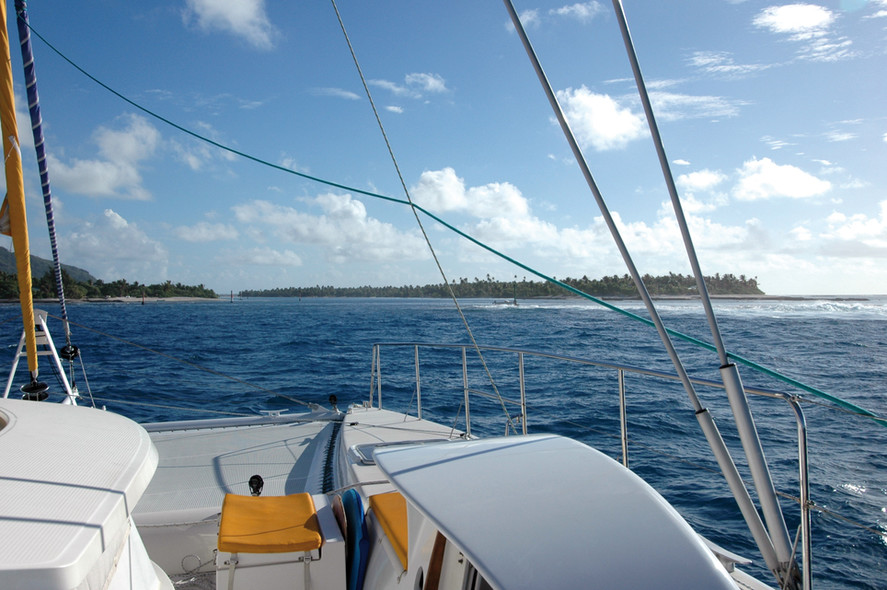
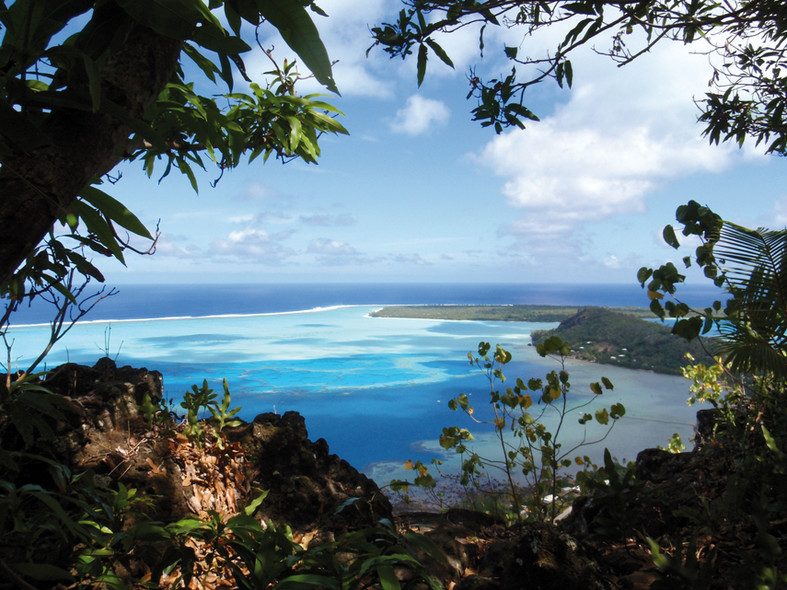
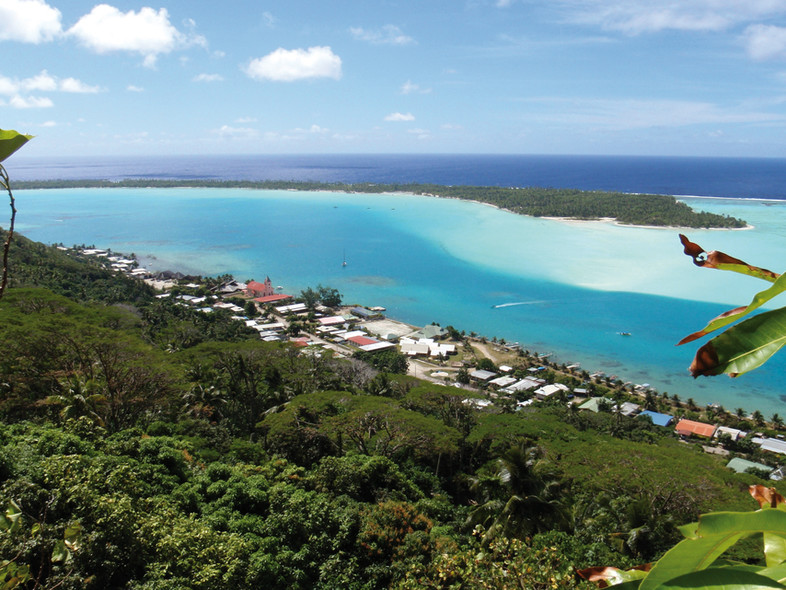
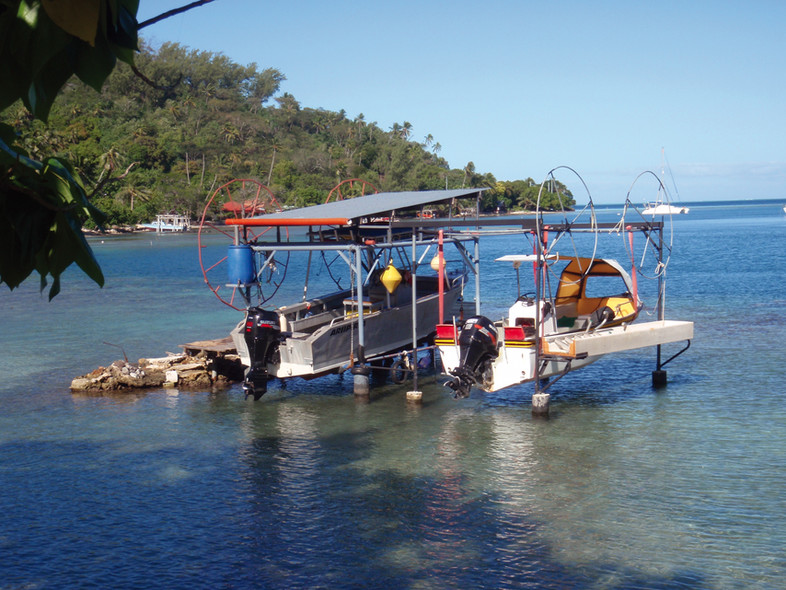
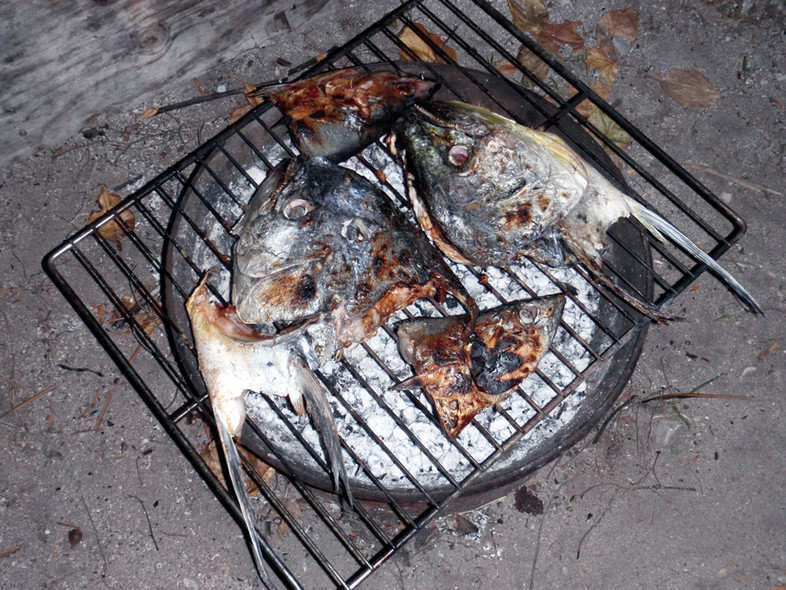
What readers think
Post a comment
Harris S.
I really enjoyed this log. I have photographed two of the picture and they are on my phone and i am envisaging myself anchored in Maupiti with my family. It sounds idyllic and the pre voyage checks and discussions with the Maupiti Express captain were a very good nod to good skippering.